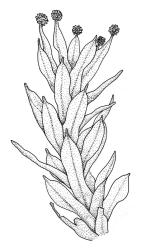The genus Calymperes can generally be distinguished from Syrrhopodon by the presence of an intra-marginal border of elongate cells ("teniola") in the shoulder region of the leaf. The teniolae often extend downwards to the base or nearly so. Unfortunately this feature is absent or nearly so in N.Z. material of C. tenerum. The upper leaf margins in this genus may be thickened, but lack elongate cells. If fruit is present, the calyptra is persistent, completely encloses the capsule, and clasps the seta. There is no peristome. Because of the high degree of variability in this large genus, no detailed generic description is given here.
Reese & Stone (1995) considered Calymperes to include c. 40 mostly tropical species worldwide and treated 14 species from northern Australia. Reese et al. (1986) treated 21 species from the Huon Peninsula of P.N.G. Only two species occur in the N.Z. Botanical Region and only one of these is documented from the main islands. Neither produce capsules here.
| 1 | Stems c. 7–10 mm; gemmae forming a globose cluster at the leaf apex, surrounding the costal tip; hyaline cells at the distal end of the cancellinae not forming interdigitating files with chlorophyllose cells; leaf margins lacking teniolae, bistratose but not strongly thickened; known from N Auckland, Chatham I., and the Kermadec Is | Calymperes tenerum |
| 1' | Stems longer, to at least 35 mm; gemmae restricted to the adaxial surface of the leaf tip; hyaline cells at the distal end of the cancellinae forming files interdigitating with chlorophyllose cells; leaf margins with well-developed teniolae below, very strongly thickened throughout; known only from the Kermadec Is | Calymperes tahitense |
| Category | Number |
|---|---|
| Indigenous (Non-endemic) | 2 |
| Total | 2 |
Calymperes graeffeanum Müll.Hal. was recorded from the Kermadec Is (Raoul I.) by Sykes 1977, as C. australe Besch.). The purported 1868 collector, Sallé, is not known to have made any other plant collections from the Kermadec Is. Calymperes graeffeanum is widespread in the Indian Ocean, Queensland and Polynesia. Beever et al. (1996) discussed the record and saw the holotype of C. australe in BM. They stated: "…it is not surprising that an otherwise obscure collector should have gathered cryptogamic material there [and] the presence of C. graeffeanum in the Kermadecs makes phytogeographic sense." It is worth noting that Reese & Stone (1995) state: "C. graeffeanum may not be easily distinguishable from C. tenerum if gemmiferous leaves are lacking. However, the cancellinae of C. graeffeanum are broader and rounded to scalariform distally, rather than truncate as in C. tenerum." If gemmiferous leaves are present, C. graeffeanum bears gemmae only on the adaxial surface of the leaf tips, in contrast to C. tenerum. Miller et al. (1978) attributed C. hyophilaceum Besch. to the Kermadec Is; this name was subsequently placed in the synonymy of C. graeffeanum by Eddy (1990). Reese & Bartlett (1982) indicated that they were unable to locate the material on which the Miller record was based. No further collections of this species from the Kermadec Is have been made since 1868 and the record must be viewed with doubt.




